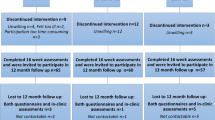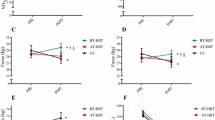Abstract
Introduction Due to large and increasing numbers of cancer survivors, long-term cancer-related health issues have become a major focus of attention. This study examined the relation between a high-intensity physical rehabilitation program and return-to-work in cancer survivors who had received chemotherapy. Methods The intervention group, consisting of 72 cancer survivors from one hospital (8 men and 64 women, mean age 49 years), followed an 18-weeks rehabilitation program including strength and interval training, and home-based activities. An age-matched control group, consisting of 38 cancer survivors (9 men and 29 women), was recruited from two other hospitals. They received only standard medical care. All subjects were evaluated during a telephone interview on employment issues, conducted at ±3 years after diagnosis. The main outcomes were change in working hours per week and time until return-to-work. Results Patients in the intervention group showed significant less reduction in working hours per week [−5.0 h/week vs. −10.8 h/week (P = .03)]. Multivariate analyses showed that the training intervention, the age of patients, and the number of working hours pre-diagnosis could explain the improvement in long-term participation at work. Time until (partial) return-to-work was 11.5 weeks for the intervention group versus 13.2 weeks for the control group (P = .40). On long-term follow-up, 78% of the participants from the intervention group versus 66% from the control group had returned to work on the pre-diagnosis level of working hours (P = .18). Conclusion Rehabilitation using high-intensity physical training is useful for working patients to minimize the decreased ability to work resulting from cancer and its treatment.



Similar content being viewed by others
References
Work committee ‘Prevalence of Cancer’. Cancer in the Netherlands: trends, prognosis and implications for management (in Dutch: Werkgroep ‘Prevalentie van kanker’: Kanker in Nederland; trends, prognoses en implicaties voor zorgvraag). Den Haag: KWF Kankerbestrijding; 2005.
Aziz NM, Rowland JH. Trends and advances in cancer survivorship research: challenge and opportunity. Semin Radiat Oncol. 2003;13(3):248–66.
Stevinson C, Lawlor DA, Fox KR. Exercise interventions for cancer patients: systematic review of controlled trials. Cancer Causes Control. 2004;15(10):1035–56.
Galvao DA, Newton RU. Review of exercise intervention studies in cancer patients. J Clin Oncol. 2005;23(4):899–909.
Knols R, Aaronson NK, Uebelhart D, Fransen J, Aufdemkampe G. Physical exercise in cancer patients during and after medical treatment: a systematic review of randomized and controlled clinical trials. J Clin Oncol. 2005;23(16):3830–42.
McNeely ML, Campbell KL, Rowe BH, Klassen TP, Mackey JR, Courneya KS. Effects of exercise on breast cancer patients and survivors: a systematic review and meta-analysis. CMAJ. 2006;175(1):34–41.
De Boer AGEM, Taskila T, Ojajärvi A, Van Dijk FJH, Verbeek JHAM. Cancer survivors and unemployment. A meta-analysis and meta-regression. JAMA. 2009;301(7):753–62.
Spelten ER, Sprangers MA, Verbeek JH. Factors reported to influence the return to work of cancer survivors: a literature review. Psychooncology. 2002;11(2):124–31.
Bieri S, Roosnek E, Helg C, Verholen F, Robert D, Chapuis B, et al. Quality of life and social integration after allogeneic hematopoietic SCT. Bone Marrow Transplant. 2008;42(12):819–27.
Spelten ER, Verbeek JH, Uitterhoeve AL, Ansink AC, van der LJ, de Reijke TM, et al. Cancer, fatigue and the return of patients to work-a prospective cohort study. Eur J Cancer. 2003;39(11):1562–7.
De Boer AG, Verbeek JH, Spelten ER, Uitterhoeve AL, Ansink AC, de Reijke TM, et al. Work ability and return-to-work in cancer patients. Br J Cancer. 2008;98(8):1342–7.
De Backer I, van BE, Vreugdenhil A, Nijziel MR, Kester AD, Schep G. High-intensity strength training improves quality of life in cancer survivors. Acta Oncol. 2007;46(8):1143–51.
De Backer I, Vreugdenhil G, Nijziel MR, Kester AD, van BE, Schep G. Long-term follow-up after cancer rehabilitation using high-intensity resistance training: persistent improvement of physical performance and quality of life. Br J Cancer. 2008;99(1):30–6.
Kremer A, Chorus A, Wevers C. TNO-survey cancer and work (in Dutch: TNO-rapport Kanker en werk). Heerhugowaard: PlantijnCasparie; 2002.
Gijsen BCM, Hellendoorn-van Vrijswijk AJH, Koppejan-Rensenbrink AG, Remie ME. Cancer and rehabilitation; Recovery & Balance an innovative program (in Dutch: Kanker en revalidatie; Herstel & Balans een innovatief programma). Almelo: Lulof druktechniek. 2005.
Mols F, Thong MS, Vreugdenhil G, van de Poll-Franse LV. Long-term cancer survivors experience work changes after diagnosis: results of a population-based study. Psychooncology. 2009;18(12):1252–60.
Taskila T, Lindbohm ML. Factors affecting cancer survivors’ employment and work ability. Acta Oncol. 2007;46(4):446–51.
Park JH, Park EC, Park JH, Kim SG, Lee SY. Job loss and re-employment of cancer patients in Korean employees: a nationwide retrospective cohort study. J Clin Oncol. 2008;26(8):1302–9.
Carlsen K, Oksbjerg DS, Frederiksen K, Diderichsen F, Johansen C. Cancer and the risk for taking early retirement pension: a Danish cohort study. Scand J Public Health. 2008;36(2):117–25.
Roelen CA, Koopmans PC, Schellart AJ, van der Beek AJ. Resuming work after cancer: a prospective study of occupational register data. J Occup Rehabil. 2011;21(3):431–40.
Berglund G, Bolund C, Gustavsson UL, Sjoden PO. Starting again–a comparison study of a group rehabilitation program for cancer patients. Acta Oncol. 1993;32(1):15–21.
Pryce J, Munir F, Haslam C. Cancer survivorship and work: symptoms, supervisor response, co-worker disclosure and work adjustment. J Occup Rehabil. 2007;17(1):83–92.
Nieuwenhuijsen K, Bos-Ransdorp B, Uitterhoeve LL, Sprangers MA, Verbeek JH. Enhanced provider communication and patient education regarding return to work in cancer survivors following curative treatment: a pilot study. J Occup Rehabil. 2006;16(4):647–57.
Dumont S, Jobin J, Deshaies G, Trudel L, Chantale M. Rehabilitation and the socio-occupational reintegration of workers who have had a myocardial infarct: a pilot study. Can J Cardiol. 1999;15(4):453–61.
Kennedy F, Haslam C, Munir F, Pryce J. Returning to work following cancer: a qualitative exploratory study into the experience of returning to work following cancer. Eur J Cancer Care (Engl). 2007;16(1):17–25.
Courneya KS, Friedenreich CM. Physical exercise and quality of life following cancer diagnosis: a literature review. Ann Behav Med. 1999;21(2):171–9.
Courneya KS, Mackey JR, Bell GJ, Jones LW, Field CJ, Fairey AS. Randomized controlled trial of exercise training in postmenopausal breast cancer survivors: cardiopulmonary and quality of life outcomes. J Clin Oncol. 2003;21(9):1660–8.
Courneya KS. Exercise in cancer survivors: an overview of research. Med Sci Sports Exerc. 2003;35(11):1846–52.
Milne HM, Willman KE, Gordon S, Courneya KS. Effects of a combined aerobic and resistance exercise program in breast cancer survivors: a randomized controlled trial. Breast Cancer Res Treat. 2008;108(2):279–88.
Acknowledgments
The authors would like to thank the Rabobank, Foundation Roparun, and the Research Foundation of the MMC Veldhoven for financial support of this study.
Conflict of interest
No commercial party having a direct financial interest in the results of the research supporting this article has or will confer a benefit upon the author(s) or upon any organization with which the author(s) is/are associated.
Author information
Authors and Affiliations
Corresponding author
Rights and permissions
About this article
Cite this article
Thijs, K.M., de Boer, A.G.E.M., Vreugdenhil, G. et al. Rehabilitation Using High-Intensity Physical Training and Long-Term Return-to-Work in Cancer Survivors. J Occup Rehabil 22, 220–229 (2012). https://doi.org/10.1007/s10926-011-9341-1
Published:
Issue Date:
DOI: https://doi.org/10.1007/s10926-011-9341-1




